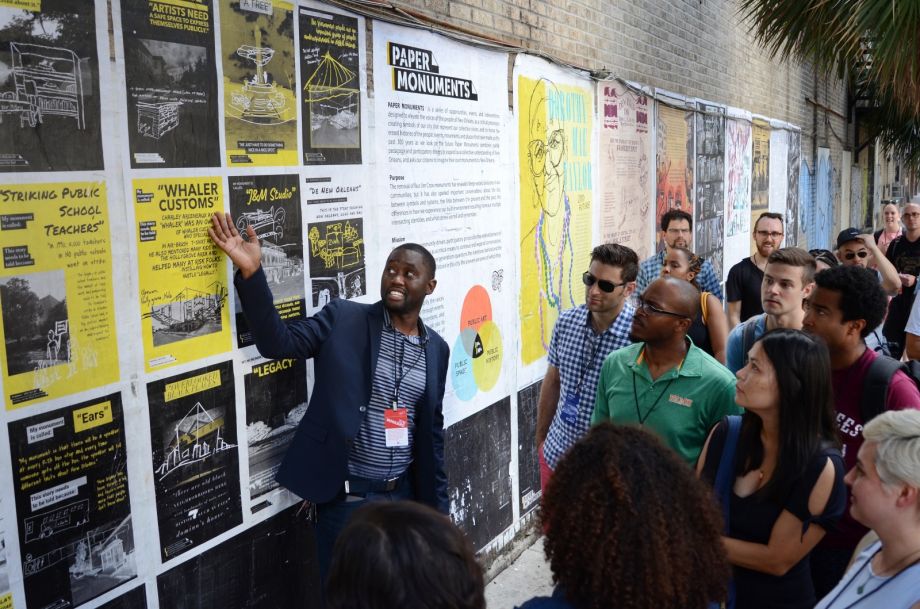Are You A Vanguard? Applications Now Open
Community wheatpasting day for the Paper Monuments Project.
Photo by Chris Daemrrich
This is your first of three free stories this month. Become a free or sustaining member to read unlimited articles, webinars and ebooks.
Become A MemberAs an architect, I often find myself at odds with a profession that, on one hand, believes architecture’s role is too large to be concerned with the plight of communities most in need, and yet too small to address structural inequalities at the core of that need. It’s hard to reconcile our work without first acknowledging that for nearly every injustice in this world, an architecture is constructed to perpetuate that injustice. Our profession overwhelmingly serves those with means and ignores the consequences of our decisions for those without means, resulting in the collective disinheritance of historically marginalized communities.
Our work is primarily in service of disinherited neighborhoods. These neighborhoods are home to the predominantly black and brown people who are disproportionately affected by the systems that determine outcomes in the built environment. Interrogating that injustice has been a pursuit for much of my career, and is now the driving motivation of our practice, Colloqate Design. We serve communities subject to this systemic disinvestment, which is often evident in the crumbling schools, boarded-up properties and crooked sidewalks that mask as infrastructure. If you’ve spent any time in marginalized communities, it’s easy to recognize that disinvestment does not correlate to a community’s vibrancy or to a disregard for urban or rural space; instead, it represents a community forced to collectively prioritize survival over aesthetic.
Disinvestment, in combination with a general distrust for the influence of development measures, leads to a survival aesthetic that at times requires a patchwork of interventions. Such interventions directly reflect community needs, often without conforming to a particular set of design standards. This set of small-scale spatial interventions is a dialogue with the community to build trust — and it is what we do with that trust that either breaks the cycle or sustains it. Holding trust and building power through the built environment is the mission of public-interest design, social-impact and design-justice practice. Through our work at Colloqate Design, we seek to expand community access to design, to build trust, and to build power through the design of social, civic, and cultural spaces.
While design and architecture have mostly chosen to ignore the struggle for social and civil rights, Colloqate has framed our work to address this void. We recognize the role of histories of inequity in shaping our society and actively address the ongoing effects of those legacies. We also work to dismantle barriers to opportunity, access and inclusion. This critical equity work is centered on the core principles of Design Justice.

Colloqate ran Paper Monuments, a participatory way to “write and 'right'” history in New Orleans. (Photo by Gigsy)
Design Justice is a movement to challenge the privilege and power structures that use architecture and design as a means to perpetuate injustice throughout the built environment. It requires the profession to design for the disempowered, the oppressed and the disinherited. In practice, this means we organize and train communities as design advocates in the pursuit of just spaces. We design knowledge-building opportunities across the country to build collective capacity around issues of inequity in the built environment. We advocate for policies and procedures that benefit communities who have been historically disinherited at the city, state and federal levels. And we design spaces for racial, social and cultural equity.
This movement towards just spaces has seen a resurgence within the profession in the last 15 years, with a renewed commitment to address the root causes of some of the world’s most intransigent issues. At the root of climate change is a built environment that exhausts 39 percent of our carbon emissions and demands 40 percent of our energy production. At the root of housing, transportation, and economic injustice are the remnants of redlining and racial covenants that continue to extract wealth and codify structural or de facto segregation. At the root of unjust policing is a prison-industrial complex sustained by spaces that extract human dignity and economic potential from marginalized people in the name of profit. At the root of food and commercial insecurity is the idea that retail (structure) follows rooftops, meaning the viability of a neighborhood is measured by the acceleration of housing values and individual assets. The force of these issues is often invisible. But they are not insurmountable.
If we validate our collective values through the spaces and places we build, than the best of who we are as designers should be to challenge the privilege and power structures that use architecture as a tool of oppression and actively forward the efforts of racial, social and cultural justice through the process and outcomes of design.
This fundamental notion that justice should be inextricably bound to all aspects of city-building is at the core of the Design Justice movement.
Bryan Lee, Jr., is an architect, educator, writer and Design Justice Advocate. He is the Founder/Design Director of Colloqate Design, a nonprofit multidisciplinary design practice, in New Orleans, Louisiana, dedicated to expanding community access to design and creating spaces of racial, social and cultural equity. He has led two award-winning youth design programs nationwide and is the founding organizer of the Design Justice Platform. He was most recently noted as one of Fast Company’s Most Creative People in Business for 2018, a USC MacArthur Civic Media Fellow, and Colloqate was the youngest design firm to win the Architectural League’s Emerging Voices award in 2019.

20th Anniversary Solutions of the Year magazine